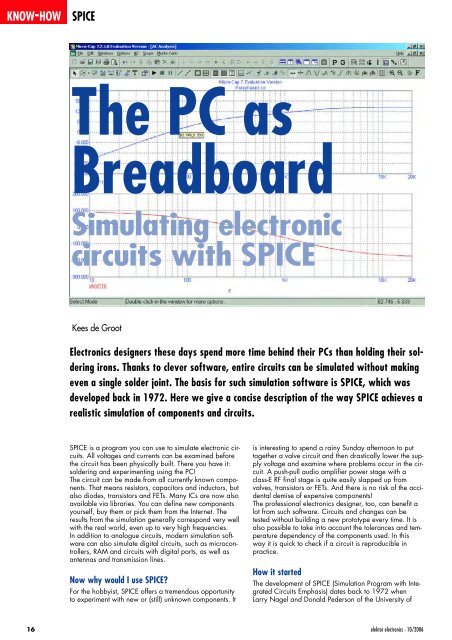FREE DVD
FREE DVD
FREE DVD
Create successful ePaper yourself
Turn your PDF publications into a flip-book with our unique Google optimized e-Paper software.
KNOW-HOW<br />
SPICE<br />
The PC as<br />
Breadboard<br />
Simulating electronic<br />
circuits with SPICE<br />
Kees de Groot<br />
Electronics designers these days spend more time behind their PCs than holding their soldering<br />
irons. Thanks to clever software, entire circuits can be simulated without making<br />
even a single solder joint. The basis for such simulation software is SPICE, which was<br />
developed back in 1972. Here we give a concise description of the way SPICE achieves a<br />
realistic simulation of components and circuits.<br />
SPICE is a program you can use to simulate electronic circuits.<br />
All voltages and currents can be examined before<br />
the circuit has been physically built. There you have it:<br />
soldering and experimenting using the PC!<br />
The circuit can be made from all currently known components.<br />
That means resistors, capacitors and inductors, but<br />
also diodes, transistors and FETs. Many ICs are now also<br />
available via libraries. You can define new components<br />
yourself, buy them or pick them from the Internet. The<br />
results from the simulation generally correspond very well<br />
with the real world, even up to very high frequencies.<br />
In addition to analogue circuits, modern simulation software<br />
can also simulate digital circuits, such as microcontrollers,<br />
RAM and circuits with digital ports, as well as<br />
antennas and transmission lines.<br />
Now why would I use SPICE?<br />
For the hobbyist, SPICE offers a tremendous opportunity<br />
to experiment with new or (still) unknown components. It<br />
is interesting to spend a rainy Sunday afternoon to put<br />
together a valve circuit and then drastically lower the supply<br />
voltage and examine where problems occur in the circuit.<br />
A push-pull audio amplifier power stage with a<br />
class-E RF final stage is quite easily slapped up from<br />
valves, transistors or FETs. And there is no risk of the accidental<br />
demise of expensive components!<br />
The professional electronics designer, too, can benefit a<br />
lot from such software. Circuits and changes can be<br />
tested without building a new prototype every time. It is<br />
also possible to take into account the tolerances and temperature<br />
dependency of the components used. In this<br />
way it is quick to check if a circuit is reproducible in<br />
practice.<br />
How it started<br />
The development of SPICE (Simulation Program with Integrated<br />
Circuits Emphasis) dates back to 1972 when<br />
Larry Nagel and Donald Pederson of the University of<br />
16<br />
elektor electronics - 10/2006

















